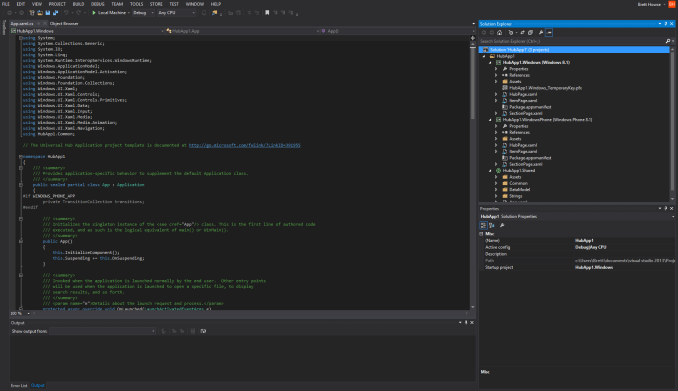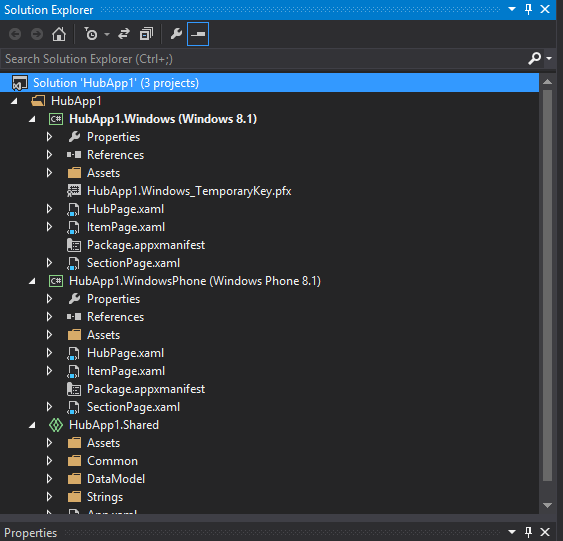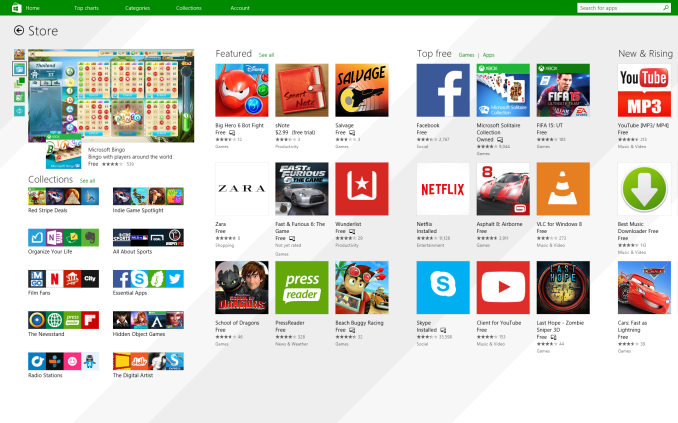Windows 10 Technical Preview First Impressions: The Return Of The Desktop
by Brett Howse on November 13, 2014 8:00 AM EST- Posted in
- Software
- Microsoft
- Windows 10
Universal Apps and the Windows Store
We just got done discussing why a single user interface for the OS across multiple devices is not always the ideal solution, so of course the obvious question with Universal Apps is why would you want it with the app model instead? Thankfully this is not the case although the term Universal App might lead people to believe they are attempting to have a single app target all of their platforms. The truth of the matter is that Universal Apps are Universal in the sense that they share a common app store.
If Microsoft is going to have Windows 10 succeed on desktops, laptops, tablets, phones, and even Xbox One, they need developer buy-in. A platform without apps is not much use to anyone. With the Universal App, they can bridge all of their platforms with a single App in the store. Under the hood, each app is created with a common framework of code, as well as multiple user interfaces in order to tailor the experience to the correct device type. Below is a screenshot of Visual Studio – Microsoft’s developer tools – with a new Universal App about to be created.
 Visual Studio Showing a Universal App Project
Visual Studio Showing a Universal App Project
As you can see, there is a shared portion of code, and then a project for the UI for Windows 8.1, and Windows Phone 8.1. Xbox One is not available yet, but should be added in a future release of Visual Studio.
A close up of the projects
But you may be wondering why any of this is necessary. Windows has the largest selection of applications of any system ever. That is of course true, and the Win32 framework has served both Windows and its users well over the years. But with the new WinRT framework there are some big advantages. First, it can be written to in multiple languages including HTML. WinRT supports C++/CX, C#, VB.NET, and HTML scripting with JavaScript and TypeScript. The security model for WinRT apps is a lot different than Win32, with all WinRT apps running in a sandbox mode for higher security. Unlike apps written in .NET, WinRT is native code, which should result in better performance. Contracts and Extensions are also new to WinRT, and allow apps to share data while still being in a sandbox. One of the biggest advantages of WinRT is that it is DPI aware, and can automatically scale apps appropriately based on screen size and screen resolution. Here, as we know, Win32 apps can struggle even though there are solutions in place.
Adobe Touch WinRT (left) vs Adobe Reader Win32 (right) on HiDPI display
One of the biggest disadvantages of WinRT is that it is only available on Windows 8 and newer devices. With Windows 8 struggling in the market as compared to Windows 7, the user reach of a developer targeting WinRT apps in the Windows Store would be for a subset of the total user base. With Windows 7 having over 50% of the desktop OS market share to itself, this is going to be an issue.
With Windows 10, Microsoft is certainly targeting Windows 7 users. If they can convince them to upgrade to the latest version of the operating system, then the new environment will have a much larger target base and will hopefully encourage developers to target the Windows Store. We have not heard of any upgrade promotions or pricing yet, but this is one of the biggest advantages Apple has had over the years. Their user base generally upgrades the OS at a much faster uptake than Windows. This allows developers to utilize newer APIs in the latest versions of their operating systems and keep the platform progressing. Microsoft has already had to deal with people being stuck on Windows XP, and they must be wanting to avoid that with Windows 7.
Since we are discussing Universal Apps and their advantages, one of the biggest advantages is the Windows Store. With Microsoft hosting the entire download and purchase of all WinRT apps, having user settings and apps sync from one device to another is much easier. One of the greatest experiences with Windows 8.1 is signing into a new PC for the first time. When you log in with your Microsoft Account, the system asks you if you would like to copy the devices and apps from one of your other devices, or if you want to start with a clean machine. If you choose a previous machine, all of the settings, wallpaper, Start Screen layout, and Windows Store apps are synced to the new device. In the case of Windows Store apps, the app itself is listed on your Start Screen, but it is not downloaded until the first time you select it. This avoids a situation where you will significantly delay the initial login time with a massive download, as well as avoid filling the available storage with apps you may not need on that particular device.
Also, like modern tablet and smartphone OSes, WinRT apps from the store are automatically kept up to date by the store. This avoids a lot of the issues with viruses and malware attacking an older version of a product since in theory it will not be around any longer.
The one thing missing from this are the older Win32 apps on the desktop, because they are not available in the Windows Store. Prior to Windows 10, desktop apps could be listed in the store, but the store would then link to the developer’s website to allow you to purchase and install the app. With Windows 10, rumors are that desktop apps will also be available and managed through the Windows Store. Assuming this does happen, then this will be a major boon to users. Desktop apps should in theory also be able to be kept up to date using the Windows Store which should cut back on the number of outdated pieces of software targeted by malware.
The Windows Store is a key piece of Windows 10. Universal Apps can be made available for multiple platforms through the store, and, if the rumors are true, even desktop apps will be available through the store. This should make the Out Of Box Experience (OOBE) very good for users with a Microsoft Account. The WinRT framework has not yet had the killer app written for it, so hopefully with Windows 10 the framework will be expanded to allow for more powerful apps to be created.













198 Comments
View All Comments
alacard - Thursday, November 13, 2014 - link
"Also, like modern tablet and smartphone OSes, WinRT apps from the store are automatically kept up to date by the store. This avoids a lot of the issues with viruses and malware attacking an older version of a product since in theory it will not be around any longer."Has anyone here heard about the recent GTAV steam debacle where they removed 17 songs from the game due to expired licensing contracts and didn't tell anyone?
https://www.techdirt.com/articles/20141110/0953552...
Yeah... the above Windows Store updates aren't a feature, they're DRM. If you can't disable that, then no windows 10/windows store sale for me. Ever.
jhoff80 - Thursday, November 13, 2014 - link
You mean GTA San Andreas, which let's keep in mind is a 10 year old game.flatrock - Thursday, November 13, 2014 - link
Auto-updating has it's risks. It's not really DRM but it does let the software publisher make changes without your explicit permission.In the example you provided Rockstar is to blame, not Steam. Rockstar should have done a better job of negotiating licenses to the songs that allowed them to be used within the game for the life of the game. The could have renegotiated extending the license period to cover continued updates. They instead chose to remove content people had paid for without warning them.
The key thing about auto-updates is that you need to be able to trust whoever provides the updates.
You can turn off auto updates for Windows 8. I don't see much reason to suspect Windows 10 won't allow it as well.
As for your example, I would suggest that you stop buying Rockstar games until they provide a solution for what they did and a clear policy on how they will avoid it in the future.
alacard - Thursday, November 13, 2014 - link
I don't own any rockstar games, nor have i ever used Steam. I do own a hacked Kindle tho, which never has network access so Amazon can't decide which books to remove on a whim (see 1984). I'm curious why you think you would be able to trust Microsoft (given their long gruesome corporate history) or any of the myriad of developers who will be creating apps for their store. Perhaps you can explain what makes them more trustworthy than any other company who licensees rather than sells their wares.We live in a world where developers have the ability to strip out content and feature on a whim, and you're talking about "trust"? Shouldn't you be talking about "laws" instead which make that kind of nonsense explicitly illegal, combined with a federal agency filled with sharp teeth dedicated to enforcing them.
Trust, really?
nathanddrews - Thursday, November 13, 2014 - link
We also live in a world of choice in a free market. Nothing is stopping you or I from sticking with Windows XP, using Linux, Windows 7, Mac OS, or any other OS. Nothing stops us from using free, open-source software instead of DRM'ed, walled garden, subscription-based applications. Everyone, individually, has to weigh the features they want against what they're willing give up. Don't elevate technological luxuries to those of legal rights. Don't like it? Don't buy it or use it.alacard - Thursday, November 13, 2014 - link
I guess you missed the part where i said the following: "If you can't disable that, then no windows 10/windows store sale for me. Ever."Do try to keep up.
nathanddrews - Thursday, November 13, 2014 - link
Good, I'm glad we agree.mga318 - Thursday, November 13, 2014 - link
Trust...Well, if you've ever used Windows Update, they've had root access for a long...long time.
alacard - Thursday, November 13, 2014 - link
Windows update has always been optional, what we're discussing most likely won't be. For Christ sake, read the thread before you comment.domboy - Friday, November 14, 2014 - link
"Auto-updating has it's risks." It sure does, and that is the biggest reservation I have with the store model regardless of operating system. I have no problem with the idea of a central software repository or package management system since various Linux distributions have used these for years. But these mobile OS (and now Windows) store systems are very in-flexible. My biggest gripe is there is no way to control versions or roll back a bad or unwanted update. Right now the best we have is to turn off auto-update and rely on somebody else to try it first and hope they post somewhere if they have a bad experience.